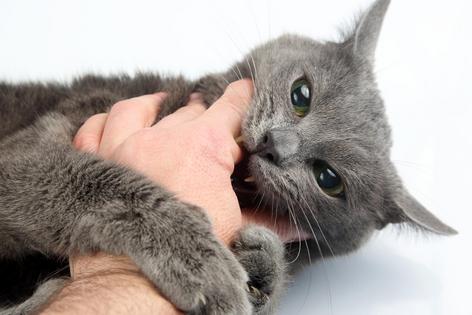My Pet World: Practical tips for managing cats that suddenly bite
Dear Cathy,
I am owned by an adorable five-year-old reverse tuxedo cat named Jasmine. When I adopted her at age three, the shelter warned me she liked to nibble hands. This was never objectionable because she is a small cat with a little mouth, and the nibbling did not damage my hand.
About six months ago, though, her bite acquired more force, and she now occasionally draws blood. I refuse to play with her until she stops chewing on me. She seems to engage in this behavior more when I haven't thrown a few dozen of her chase toys for her. I assume she is bored or angry at me. I leave her alone at this point; I have learned she likes her chill time.
I don't think she is trying to injure me, as she could easily do that with her claws if that were her intention. She is healthy. She has several large cat trees, many cat wands, toys, and cat grass to chew on, and there is a window where she can look out on her kingdom.
I look forward to hearing your thoughts.
— Richard, Allentown, Pennsylvania
Dear Richard,
Cats are highly sensitive to touch and stimuli, and as caretakers, we may unintentionally upset them. Overstimulation in cats often leads to biting, serving as their way of signaling discomfort or displeasure. This behavior is known as petting-induced or overstimulation aggression. Understanding why cats bite allows for the identification and elimination of triggers.
Cat play mirrors hunting behavior, involving stalking, pouncing, and biting. When cats bite their prey, they hold on until it stops moving. To release her grip, remain still until she stops biting, and then calmly walk away. Never use your hands to play with her; instead, use stuffed socks, wire wands, lure toys, or lasers to cater to her natural play instincts.
While it's instinctive to pet cats, respecting their preferences is essential. Learn your cat's tolerance for touch, watching for warning signs such as ears twitching back, dilated pupils, and a rigid, slow-moving tail. By respecting your cat's boundaries, you can avoid sudden bites. Pay attention to your cat's cues and limit petting accordingly. She may not tolerate extensive petting but still may enjoy sitting in your lap.
You are correct in saying this behavior worsens when you haven't had time to play with her. She is not mad, but she could be bored. Regular exercise helps reduce petting-induced and overstimulation aggression by releasing pent-up energy. Engage her in play for at least 10 minutes, two to three times a day, using various toys and encouraging her to run up and down her cat trees with a laser pointer.
Finally, use feline pheromones, whether through a collar, spray, or plug-in, to reduce some of her anxiety, which may also help with this type of biting. Understanding her behavior and preferences and providing appropriate play and relaxation outlets can significantly reduce her biting.
Dear Cathy,
I have had three dogs, and I wanted to make a recommendation to your readers. If the vet allows it, the owners should be present in the room when they put their dogs to sleep. Each time, I found the experience very peaceful. The dog goes to sleep, and I know that the suffering is over for my furry loved one.
— Doug, Salem, Virginia
Dear Doug,
I wholeheartedly agree. When it comes to a pet's final moments, being present and holding them is a compassionate choice. Pets may feel scared or anxious in an unfamiliar exam room, and your decision to be present can make all the difference.
In December, I faced the difficult decision to euthanize my 14-year-old dog, Buster. As I spoke to him and provided comfort, a vet tech entered the room and said she needed to take him to another room so they could insert the IV. I had brought Buster in on a dog bed because he was struggling to walk. So, I requested they pull him on the bed into the other room, and then drag him back on the bed when they were finished.
After a brief interval, I heard Buster making his way down the hall on his own. Despite his struggle, he was determined to return to my side. In that crucial moment, his need to be with me was evident.
While I understand this is a challenging experience for many, being present during your pet's final moments can offer a sense of closure. I echo Doug's perspective: It is a peaceful process that alleviates any suffering your pet may be enduring and the final gift of love you can give to your pet.
_____
_____
========
(Cathy M. Rosenthal is a longtime animal advocate, author, columnist and pet expert who has more than 25 years in the animal welfare field. Send your pet questions, stories and tips to cathy@petpundit.com. Please include your name, city, and state. You can follow her @cathymrosenthal.)
©2024 Tribune Content Agency, LLC.
(c) 2024 DISTRIBUTED BY TRIBUNE MEDIA SERVICES, INC.










